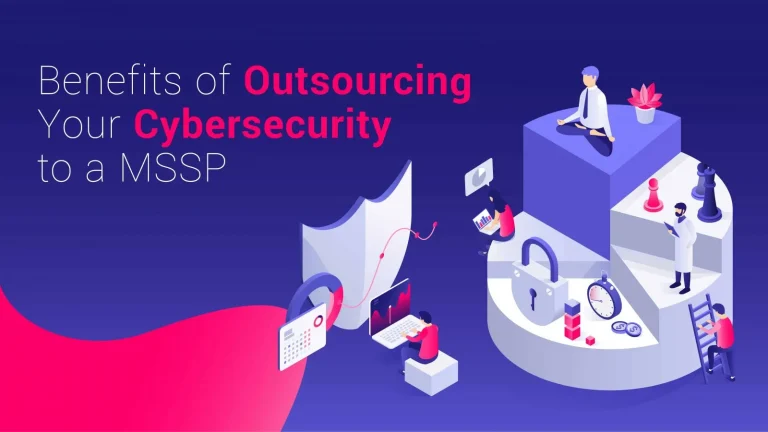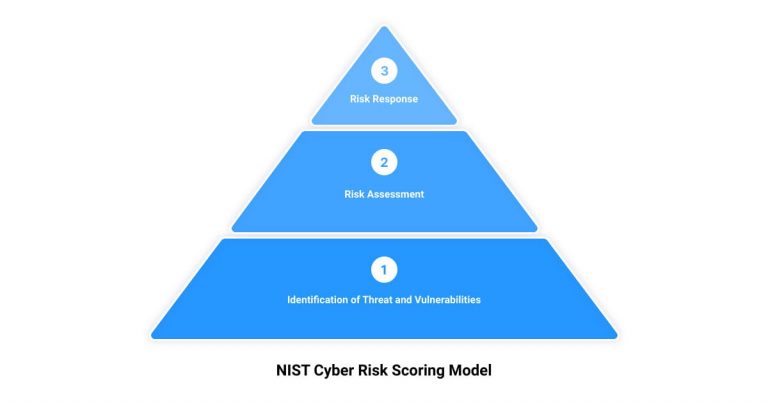As we navigate a digitally-minded landscape, understanding your company’s cyber risks has never been more crucial. For us at Upper Echelon Technology Group, we believe it all begins with understanding a concept called cybersecurity risk profiles. So, what is a cybersecurity risk profile example? Simply put, it’s an assessment tool that provides a detailed overview of an organization’s susceptibility to cyber threats. Its aim? To identify, analyze, and evaluate potential risks that could undermine the integrity and function of your precious data resources.
The complexity of cybersecurity risks can be downright daunting, but it doesn’t have to be that way. You see, a cybersecurity risk profile allows you to peel back the layers of this complexity, breaking down the usually overwhelming cyberspace into manageable parts.
Imagine this: A storm is forecasted in your region. You could ignore the warning and potentially face serious damages. Or, you could assess the risks — the intensity of the storm, the weakness of your roof, the possibility of a power outage — and make necessary preparations. The latter option is the essence of a cybersecurity risk profile. It’s your business’s own weather prediction system in the digital world.
In short, a real-life cybersecurity risk profile can potentially save your business from costly, even catastrophic, breaches. To that end, we’ve put together an approachable guide to understanding this crucial component of cybersecurity — starting with an examination of the three main components of a risk profile.
Here’s a quick snapshot:
- Risk Capacity: Your organization’s ability to weather the storm after a data breach.
- Risk Tolerance: The level of risks your organization is willing to shoulder to accomplish its objectives.
- Risk Requirement: The necessary risks your business must establish to achieve its goals.
This article aims to guide you through each layer, culminating in a detailed real-life example of a cybersecurity risk profile from our experiences at Upper Echelon Technology Group. Let’s get started.
Understanding the Components of a Cybersecurity Risk Profile
A comprehensive cybersecurity risk profile is a critical tool in managing and mitigating cyber threats. It provides a clear picture of an organization’s risk landscape, helping to inform strategic planning and decision-making processes. The creation of such a profile involves a deep dive into three primary components: risk capacity, risk tolerance, and risk requirement. Understanding these components is crucial in forming a robust cybersecurity strategy.
Risk Capacity: The Ability to Absorb Losses
Risk capacity refers to an organization’s ability to withstand losses from potential cyber threats. It’s about gauging the level of financial or operational damage your business can endure without significant disruption. For instance, if a cyber-attack compromises your data, how much downtime can your business tolerate without severe consequences?
In assessing this, we look at your assets, financial resources, and operational resilience. We consider the potential impact of a cyber-attack on your business continuity, reputation, and bottom line. Identifying your risk capacity enables us to tailor a cybersecurity strategy that ensures your business can quickly bounce back in the face of cyber threats.
Risk Tolerance: The Level of Risk an Organization is Willing to Accept
Risk tolerance is about understanding the level of risk that your organization is willing to shoulder. It’s a measure of how much uncertainty you’re prepared to accept in pursuit of your objectives. This component heavily depends on the nature of your business, the industry you operate in, and your overall business strategy.
At Upper Echelon Technology Group, we work closely with you to determine your risk tolerance. This process involves open discussions about the potential cyber threats your business may face and the level of risk you’re comfortable with. It’s about finding a balance between protecting your business and ensuring that necessary risks are taken to drive growth and innovation.
Risk Requirement: The Level of Risk an Organization Must Take to Achieve its Goals
The final component of a cybersecurity risk profile is the risk requirement. This refers to the level of risk your organization must undertake to achieve its strategic objectives. In a world where businesses increasingly rely on technology for growth and innovation, some level of risk is inevitable.
For instance, adopting new technologies or entering new markets might expose your business to certain cyber threats. However, these actions might be necessary to stay competitive and achieve your goals. By understanding the risk requirement, we can help you navigate these risks effectively, ensuring that your business remains protected while pursuing its strategic objectives.
At Upper Echelon Technology Group, we believe that a thorough understanding of these components aids in crafting a cybersecurity strategy that aligns with your business objectives. By working closely with you, we can develop a cybersecurity risk profile that accurately reflects your business’s risk landscape. This approach ensures that your cybersecurity strategy not only protects your business but also supports your growth and innovation goals. To further delve into this topic, you can explore our other articles on cyber security risk assessments.
The NIST Framework: A Foundation for Cybersecurity Risk Profiles
As a cybersecurity-focused managed services provider, we at Upper Echelon Technology Group are aware of the critical role the National Institute of Standards and Technology (NIST) Framework plays in shaping a robust cybersecurity risk profile.
The Role of the NIST Framework in Cybersecurity Risk Management
The NIST Framework serves as a guide for organizations to better manage and reduce cybersecurity risk. Apart from providing a common language, it offers a set of industry standards and best practices to manage cybersecurity risks in a cost-effective way. This framework is adaptable to various businesses or organizations regardless of their size, risk exposure, or cybersecurity sophistication.
One of the recognized features of the NIST Framework is what is known as the CRI Profile, which is a customization of the NIST Cybersecurity Framework. It is a tool that financial institutions can use for internal and external cyber risk management assessment and as evidence for compliance. The versatility and comprehensiveness of the NIST Framework make it a solid foundation for any cybersecurity risk profile.
The Four Levels of Cybersecurity Risk Management Sophistication
The NIST Framework breaks down cybersecurity risk management into four tiers, each representing a degree of sophistication in managing cybersecurity risk.
- Partial (Tier 1): Organizations at this level have limited awareness of cybersecurity risk and lack formalized risk management practices.
- Risk Informed (Tier 2): At this level, organizations have established risk management practices but they may not be consistently applied across the organization.
- Repeatable (Tier 3): Organizations at this level have formal risk management practices that are regularly updated based on the application of lessons learned and predictive indicators.
- Adaptive (Tier 4): Organizations at the highest level dynamically adapt their risk management practices based on lessons learned and predictive indicators derived from previous and current cybersecurity activities.
Creating a cybersecurity risk profile example that reflects your company’s level of risk management sophistication can be complex. However, we at Upper Echelon Technology Group can help you navigate this process. By leveraging our technology assets and personalized approach to IT Managed Services, we can help you create a cybersecurity risk profile that effectively addresses your business needs. Discover more about our unique approach to managing cybersecurity risks in our other articles on assessing cybersecurity risk and cybersecurity risk profile.
A Real-Life Cybersecurity Risk Profile Example: Upper Echelon Technology Group LLC
At Upper Echelon Technology Group, our personalized approach to IT Managed Services includes a comprehensive cybersecurity risk profile. This profile is an essential tool for identifying and mitigating risks that could impact your business operations. Let’s dive into the key components of a cybersecurity risk profile through the lens of our real-life work.
Current-State Analysis: Identifying Information Risk Factors
First, we conduct a current-state analysis to identify the information risk factors that your business might be exposed to. This crucial step involves a deep-dive into your digital environment, considering aspects like system vulnerabilities, data sensitivity, and any potential threats. This analysis is made understandable to both business-oriented and technology-oriented personnel, ensuring everyone is on the same page regarding the risks at hand.
Threat Analysis: Understanding the Types of Threats the Organization Faces
Next, we carry out a thorough threat analysis. This process involves understanding the types of threats your organization faces, their potential impact, and the likelihood of them happening. For example, if a vulnerability exists in your web application, an unauthorized user might exploit it and access sensitive customer data. We assess this possibility and its potential consequences to ensure your business is prepared for any cyber threats.
Measured Risk: How Threats Impact the Organization
Once we have identified and understood the potential threats, we measure the risk. This involves assessing how these threats could impact your business operations. For instance, a data breach could lead to financial losses, reputational damage, and regulatory penalties. By quantifying these potential impacts, we can prioritize which risks need immediate attention and which can be managed over time.
Risk Mitigation: Establishing a Roadmap for Reducing Cybersecurity Risk
Finally, armed with this detailed understanding of your cybersecurity landscape, we craft a customized risk mitigation plan. This plan is essentially a roadmap for reducing cybersecurity risk, outlining the steps your business needs to take to bolster its security defenses. It includes recommendations for implementing effective security controls aligned with your organization’s risk tolerance and capacity – all aimed at ensuring the highest level of information risk mitigation.
In essence, our cybersecurity risk profile is a dynamic tool that evolves with your business, helping you navigate the complex cyber landscape with confidence. If you’d like to explore more about our approach to managing cybersecurity risks, check out our other resources on cyber security risk assessments.
User Risk Profiles: The Human Element in Cybersecurity
In the complex world of cybersecurity, there’s a critical element that often gets overlooked: the user. Users, whether they’re employees or contractors, can unknowingly engage in risky online actions that can expose your organization to cybersecurity threats. It’s crucial to understand this human element to better manage and mitigate risks. In fact, a cybersecurity risk profile example wouldn’t be complete without a deep dive into user risk profiles.
Measuring and Monitoring User Risk
Just as you’d track the credit risk of an individual based on their past actions and various characteristics, the same principle applies to user risk in cybersecurity. We evaluate factors such as the individual’s access to data and applications and the likelihood of them becoming a target of attacks.
This process involves monitoring the online actions of users at an individual, departmental, and organizational level. We quantify this risk in a user risk score, which essentially “grades” each user’s cybersecurity behavior.
For instance, let’s consider the example of two employees, Josie and Steven. Josie detected and reported all phishing emails she received, earning her a high user risk score. Steven, on the other hand, failed to detect and report some phishing emails, earning him a lower score. This simple example illustrates how we can measure and monitor user risk.
Identifying High-Risk Users and Assessing Their Risk to the Organization
Identifying high-risk users is a crucial step in managing cybersecurity risk. As in our example, Steven would be considered a high-risk user due to his actions (or lack thereof) in response to phishing attempts.
However, it’s not just about actions. We also consider the level of access and exposure an individual has. For instance, an individual with extensive access to sensitive data or systems, or someone who is frequently targeted by cyber attacks, would be considered high risk.
Mitifying User Risk: Limiting Access to Sensitive Data and Tailoring Security Controls
Once we’ve identified high-risk users, the next step is to implement strategies to mitigate their risk. This could involve limiting their access to sensitive data or tailoring security controls based on their user risk profile.
For instance, in the case of Steven, we might limit his access to sensitive data, provide additional training, or implement stricter security controls when he’s accessing company systems.
Remember, understanding and managing user risk is an ongoing process. It’s not just about identifying high-risk users – it’s about continuously monitoring and adjusting controls as needed.
By integrating user risk profiles into your cybersecurity risk assessment, you can better protect your organization from the inside out. For more information on this topic and related ones, head over to our cyber security risk assessments page to get a complete overview.
Practical Tips for Improving Cybersecurity and Managing Risk
Now that we’ve painted a picture of a real-life cybersecurity risk profile example, let’s delve into some practical tips that can help improve your cybersecurity and manage risk more effectively.
Identifying Real Risks and Refining Risk Appetite with Management
First things first, identify the real risks that your organization faces. Don’t get caught up in the hype of potential threats that may not pertain to your specific situation. Work with your management team to refine your overall risk appetite. It’s crucial to understand what level of risk your organization is willing to accept as part of its operations.
Understanding Important Information and Access Needs
Once you’ve identified the risks, focus on understanding which information is most important and who really needs access to it. This understanding forms the foundation of a robust cyber risk management process.
Assessing Vulnerability in the Threat Landscape and Protecting Critical Assets
Take a look at the broader threat landscape to understand where your organization is most vulnerable. It’s essential to identify and protect your “crown jewels” – the assets that are most critical to your business’s operations and success.
Making Everyone Accountable and Prioritizing Cybersecurity at the Board Level
Cybersecurity isn’t just an IT problem; it’s an organization-wide responsibility. Everyone in your organization should be accountable for it. Emphasize this accountability and ensure that cybersecurity remains a board-level priority.
Establishing Objectives and Metrics, Taking a Portfolio Approach to Security, and Partnering When Needed
Establish clear cybersecurity objectives and metrics. This provides a roadmap and enables you to measure progress. Take a portfolio approach to security, meaning you consider all aspects of security (PCI, Audit, SOX, information, privacy, physical, and BCP) collectively rather than in silos.
Finally, don’t hesitate to partner with external experts, like us at Upper Echelon Technology Group, when it makes sense and when you need to add capability. Our Managed IT Services can help you navigate the complex landscape of cybersecurity and ensure your defenses are strong.
Remember, improving cybersecurity and managing risk is an ongoing journey. With these practical tips in mind, you’re well on your way to bolstering your organization’s defenses and reducing your cybersecurity risk.
Conclusion: The Value of a Comprehensive Cybersecurity Risk Profile
Understanding your organization’s cybersecurity risk profile is a crucial part of safeguarding your business in today’s digital landscape. It goes beyond just identifying threats—it involves a deep understanding of your organization’s risk capacity, risk tolerance, and risk requirement. A comprehensive cybersecurity risk profile is your guide to understanding potential risks and determining the best ways to mitigate them.
At Upper Echelon Technology Group, we recognize the importance of a detailed and robust cybersecurity risk profile. As a cybersecurity-focused managed services provider, we work with clients to build and refine their risk profile, taking into account their unique business needs and situation. Our goal is to not just ‘fix tech issues,’ but to help you leverage your technology assets in the most secure and efficient way possible.
Creating a comprehensive cybersecurity risk profile is a collaborative process. It involves working closely with your team to understand your organization’s assets, identify potential threats, evaluate your risk tolerance, and develop a roadmap for reducing cybersecurity risk. We also factor in the human element, assessing user risk profiles to understand how individual behaviors can impact overall security.
In the end, a well-crafted cybersecurity risk profile not only helps protect your business from potential threats but also empowers you to make informed decisions about technology investments and security measures. It’s an indispensable tool in your cybersecurity arsenal, one that can ultimately contribute to your company’s profitability and success.
As we wrap up this discussion on a real-life cybersecurity risk profile example, we hope you’ve gained valuable insights into the importance of assessing cybersecurity risk and how it can be effectively managed. Remember, cybersecurity is not a one-time task but an ongoing process that requires constant vigilance and adaptation.
For more information on cybersecurity risk assessments, check out our overview page and related subtopic pages like assessing cybersecurity risk and cybersecurity risk assessment and management. You can also contact us directly to discuss your specific needs. We’re here to help you navigate the complex world of cybersecurity and ensure your organization is well-protected against potential threats.
Remember, in the world of cybersecurity, knowledge is power. Protect your business by understanding your risk, and take the necessary steps to mitigate it. Stay safe out there!






